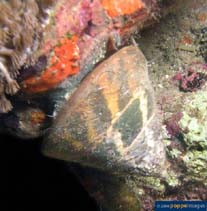Tectus pyramis (Born, 1778)
Pyramid top| Native range | All suitable habitat | Point map | Year 2050 |

|
| This map was computer-generated and has not yet been reviewed. |
| Tectus pyramis AquaMaps Data sources: GBIF OBIS |
Classification / Names Common names | Synonyms | CoL | ITIS | WoRMS
Gastropoda | Trochida | Tegulidae
Environment: milieu / climate zone / depth range / distribution range Ecology
Benthic; depth range 0 - 10 m (Ref. 349). Tropical; 38°N - 30°S, 42°E - 168°W
Distribution Countries | FAO areas | Ecosystems | Occurrences | Introductions
Indo-Pacific: from Madagascar, India, Sri Lanka, Andaman and Nicobar Islands, and Christmas Island, to the entire Southeast Asia and Australia, east to American Samoa, and north to Japan and China.
Length at first maturity / Size / Weight / Age
Maturity: Lm ? range ? - ? cm Max length : 15.0 cm SHL male/unsexed; (Ref. 349); common length : 8.0 cm SHL male/unsexed; (Ref. 349)
Short description Morphology
Large, conical shell. Spire tall, with pointed apex and flat-sided whorls. Umbilicus present. Colouration: Outside of shell slightly grey to brown speckled or green speckled. Base of shell creamy borwn, green or blue-green towards periphery, white and glossy towards aperture (Ref. 128042).
Life cycle and mating behavior Maturity | Reproduction | Spawning | Eggs | Fecundity | Larvae
Members of the order Archaeogastropoda are mostly gonochoric and broadcast spawners. Life cycle: Embryos develop into planktonic trocophore larvae and later into juvenile veligers before becoming fully grown adults.
Main reference
References | Coordinator | Collaborators
Poutiers, J.M. 1998. (Ref. 349)
IUCN Red List Status (Ref. 130435: Version 2024-1)
CITES status (Ref. 108899)
Not Evaluated
CMS (Ref. 116361)
Not Evaluated
Threat to humans
Harmless
Human uses
Fisheries: commercial
| FishSource | Sea Around Us
Tools
More information
Trophic Ecology
Ecology
Population dynamics
Life cycle
Distribution
Human Related
Aquaculture profile
Stamps, Coins Misc.
Stamps, Coins Misc.
Outreach
References
Internet sources
BHL | BOLD Systems | CISTI | DiscoverLife | FAO(Publication : search) | Fishipedia | GenBank (genome, nucleotide) | GloBI | Gomexsi | Google Books | Google Scholar | Google | PubMed | Tree of Life | Wikipedia (Go, Search) | Zoological Record
Estimates based on models
Preferred temperature
(Ref. 115969): 24.9 - 29.3, mean 28.5 (based on 2891 cells).
Price category
(Ref. 80766):
Unknown.
Nutrients : Calcium = 126 [75, 177] mg/100g; Iron = 4.79 [1.67, 7.92] mg/100g; Protein = 15.9 [14.8, 16.9] %; Omega3 = 0.331 [0.263, 0.400] g/100g; Selenium = 57.8 [48.5, 67.2] μg/100g; VitaminA = 0 μg/100g; Zinc = 1.97 [0.92, 3.02] mg/100g (wet weight); based on nutrient studies.



